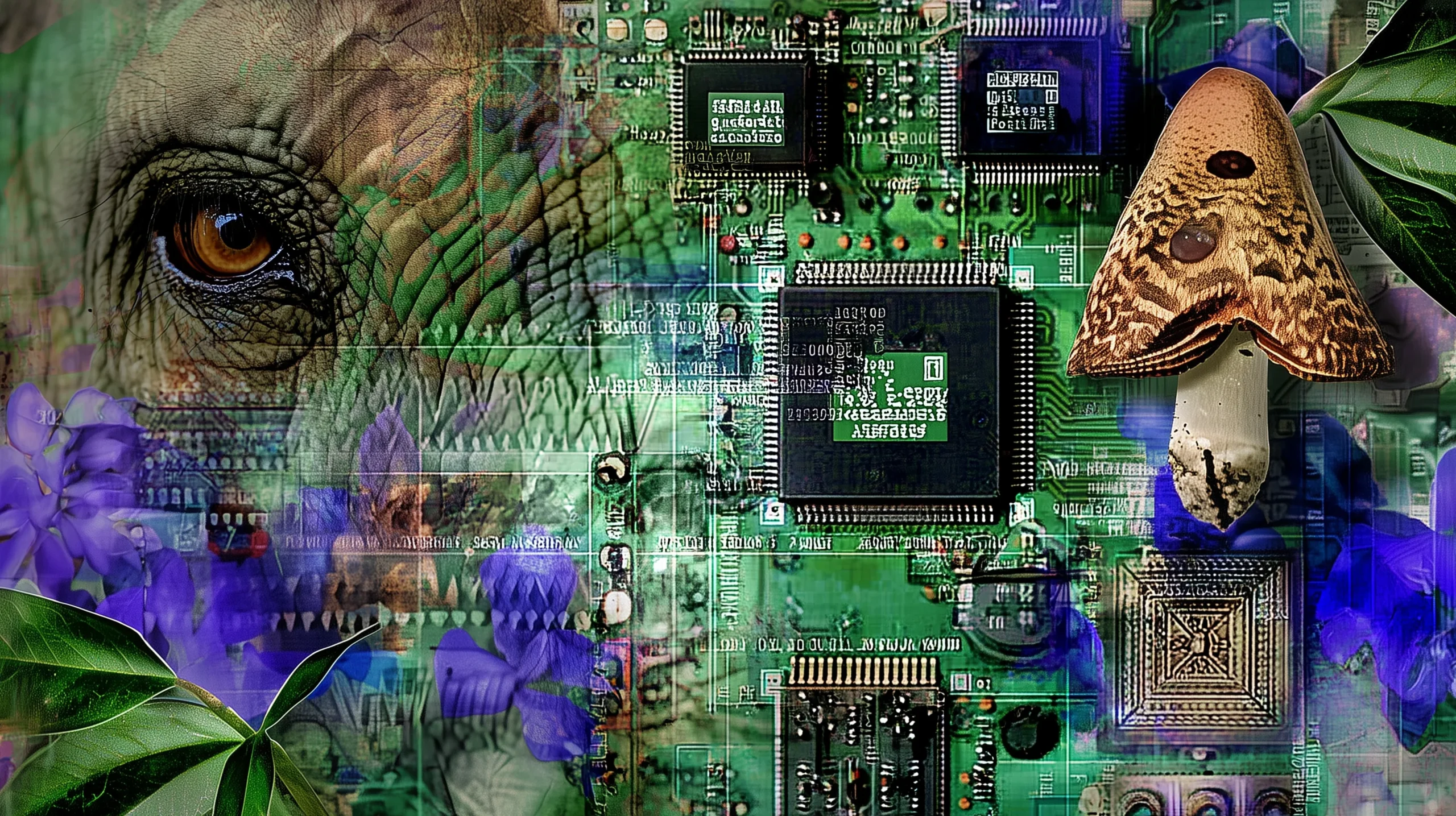Mapping the outer & inner horizons of a “sky-dream” species
“On small screens, use landscape mode for better table view.”
| Layer | Also called | Main feature | Typical experience | Key practice |
|---|---|---|---|---|
| 7. Primordial Awareness | Turiya, Rigpa, Pure Knowing | Silent, formless witness that never changes | Pure knowing of every state without being altered | Rest as simple noticing and non-grasping presence |
| 6. Conscious Field | Waking, Dreaming, Deep-sleep potential | Light of awareness passing through mind and body | Sights, sounds, thoughts, images, or the blankness of deep sleep | Moment-to-moment mindfulness |
| 5. Spirit Function | Logos, creative spark | Insight, purpose, moral vision, ecstatic clarity | Sudden inspiration, revelations, guiding intuition | Contemplation, study, selfless service, prayer |
| 4. Psyche | Inner world (collective and personal) | Storehouse of symbols and instincts | Archetypes such as gods, angels, demons, heroes, shadows; active imagination and intuition | Shadow work, dream work, symbolic art, creative expression |
| 3. Soul Function | Feeling bridge, anima–animus | Adds meaning, depth, and relatedness | Longing, intimacy, values, relational depth | Authentic feeling, journaling, ritual, art |
| 2. Ego-Mind | Personality, storyteller | Organises identity, plans, and defends | “I am this,” past or future narrative, roles and preferences | Self-inquiry, cognitive clarity, humility training |
| 1. Body | Soma, living vessel | Sensory gateway that stores implicit memory | Breath, heartbeat, posture, pain, pleasure | Grounding, breath work, movement, rest |
Journey: Start with the living body, clarify the ego, open the soul, read the symbols of psyche, ignite the guiding spirit, dwell in the luminous conscious field, and recognise the silent sky of primordial awareness.
Seven Skies of Being: Full Read
Seven-tier chart sketches a ladder from dense embodiment (Body) to formless awareness (Primordial Awareness).
Brain-computer interfaces (BCIs) promise to extend tiers 1-3—the bodily sensorium, the organising ego-mind, perhaps even the “feeling bridge”—while psychedelics can illuminate tiers 3-6 by loosening habitual frames and exposing shadow material.
Below is a research-oriented panorama showing how the two technologies might be braided so progress remains balanced, not lopsided.
1 · Outer progress ― state-of-the-art BCIs
| Platform | In-human status | Technical signature | Direction of travel |
|---|---|---|---|
| Neuralink | First human implant (Jan 2024) now lets a quadriplegic post on X and browse the web by thought; FDA breakthrough status; US$600 m raise in May 2025 pushes valuation to ≈ US$9 bn. (Neuralink, Reuters) | 1 000-channel “N1” threads robot-sewn into motor cortex | Scaling channel-count, wireless power, and full 6-DoF cursor control |
| Synchron | Six-patient COMMAND study shows 0 serious neuro-safety events at 12 mo; Stentrode delivered endovascularly via jugular vein. (Endovascular Today) | Mesh “stent-electrode” expands against vessel wall | Least-invasive path to typing & smart-home control |
| Precision Neuroscience | Pre-clinical; “Layer 7” cortical film slips under skull through 1-cm slit; thousands of electrodes without penetrating tissue. (precisionneuro.io) | Ultrathin μECoG | Target: day-surgery upgrade kits for stroke/ALS |
| Blackrock Neurotech | 30 + humans with Utah array since 2004; portable “MoveAgain” system aims for first commercial launch. (Blackrock Neurotech) | 96-spike intracortical array | Focus: motor/communication restoration |
Trajectory (2025-2035): Medical indications will dominate the next decade—paralysis, locked-in syndrome, epilepsy, visual prostheses—because risk tolerance, regulatory hurdles, and surgical burden remain high.
Enhancement-oriented implants (memory, attention, synthetic telepathy) sit further out, but the capital now flowing into Neuralink and its rivals shows that an upgrade path for healthy users is already envisaged.
2 · Inner progress ― psychedelics as consciousness technology
- Evidence base. Psilocybin produced rapid, durable relief of depression in frontline clinicians (randomised trial, 2024) (PubMed). Two large MDMA-for-PTSD trials were positive, yet the FDA rejected the New Drug Application in Aug 2024, citing methodological concerns, signalling a cautious gatekeeper stance (clinicaltrialvanguard.com).
- Regulated access models. Oregon opened supervised psilocybin services in 2023; Colorado’s Natural Medicine Program began licensing facilitators and healing centres in Jan 2025, with the first psilocybin sessions expected mid-year (Colorado Newsline).
- Facilitator training pipelines. State-approved curricula now exceed 150 hours didactic plus supervised practicum (e.g., Synthesis Institute, InnerTrek, Naropa) to ensure practitioners can hold intense experiences and guide integration (Synthesis Institute, InnerTrek Training & Services, Naropa University).
These developments make psychedelic-assisted self-inquiry a maturing clinical craft rather than a fringe rite.
3 · Meeting place ― ethics & neuro-spiritual readiness
Peer-reviewed overviews warn that enhancement BCIs raise profound questions about autonomy, privacy, and the continuity of the self—issues that lie squarely in the tier 4–7 zones. (PubMed).
Psychedelic work surfaces the same themes experientially: boundary dissolution, agency, ego death. Thus, psychedelic literacy could act as “inoculation” against the psychological shocks of direct brain augmentation, much as divers practise pressure-equalisation before deep descents.
Key convergence points:
- Agency calibration. Psychedelics teach surrender and intentionality; BCIs will require users to distinguish idle mentation from deliberate command streams.
- Shadow integration. Unprocessed trauma can leak into algorithmic loops—e.g., inadvertent hostile tweets via a thought-cursor. Guided psychedelic work exposes and integrates these patterns beforehand.
- Consent literacy. Both techs necessitate expanded informed-consent frameworks that cover data exhaust (“neural exhaust”) and post-session integration responsibilities.
4 · A phased research agenda
| Phase | Objective | Methods | Milestones (illustrative) |
|---|---|---|---|
| I · Cartography | Map phenomenology across tiers during non-invasive BCIs (EEG, fNIRS) and psychedelics separately | Multimodal neuroimaging + microphenomenological interviews | Common neural fingerprints of “ego dissolution” vs “cursor intention” |
| II · Preparatory protocols | Develop psychedelics-assisted readiness programs for candidate implant recipients | 6-week course: mindfulness, two facilitated psilocybin sessions, shadow-work homework | Psychometrics: reduced trait reactivity, improved metacognitive accuracy |
| III · Co-development pilots | Implant recipients who completed Phase II; examine performance, mental-health, and existential wellbeing vs controls | n = 30 crossover study; continuous ECoG decoding + digital phenotyping | SAE, agency-confusion incidents, quality-of-life scores |
| IV · Governance & rights | Draft “neuro-rights” charters with stakeholder input (patients, ethicists, Indigenous groups) | Delphi panels + citizen assemblies | Legislation proposals mirroring GDPR for brain data |
This design lets inner cultivation pace and inform outer hardware, preventing a scenario where humanity upgrades its “motor cortex bandwidth” while leaving its moral-emotional firmware at version 1.0.
5 · Question
Should people be educated about psychedelics before introducing the AI brain chip?
Yes—if the goal is balanced evolution. Outward tech alone already lowers certain forms of suffering (mobility, communication) yet cannot, by itself, transmute the deeper dukkha generated by unexamined beliefs and reactive egos. Structured psychedelic education (clinical-grade set, setting, and integration) offers a pragmatic route to:
- make the subconscious architecture of belief visible,
- rehearse the relinquishing of control that invasive BCIs will eventually demand,
- and exercise the “Spirit Function” (tier 5) so that tier 6’s “Conscious Field” can host new machine symbionts without being colonised by them.
In short, psychedelics function as inner firmware updaters, while BCIs are hardware expansions. Rolling out hardware upgrades without the corresponding firmware patch risks system instability—Exactly the scenario the Seven Skies of Being sky-dream framework seeks to avoid.
Humanity’s next leap may not be “man becomes machine”, but man learns to steward machines from a more luminous tier of his own consciousness. The research path above invites us to climb the ladder on both sides—silicon and psyche—so the dream remains lucid and shared.
Psilocybin-Assisted Preparation and Neuralink BCI Integration
How does a structured psychedelic-assisted preparation program affect agency control, psychological well-being, and decoding performance in humans receiving an invasive AI brain–computer interface, compared with implant recipients who receive standard (non-psychedelic) preparation?
Summary of the main ideas
- Psilocybin “reboots” the brain. One strong dose quiets the brain’s self-talk network (the Default Mode Network) and lets different regions talk to each other in new ways. This creates a 1-to-2-week “learning window” when the brain is extra flexible.
- Better learning for Neuralink. During this flexible window the brain may pick up Neuralink skills faster, because it can form new signal patterns more easily.
- Train after the trip, not during. While the trip lasts (about 4–6 hours) attention and memory get worse, so BCI training should wait at least two days until thinking is clear again.
- Mood boost and emotional healing. Guided psilocybin therapy often cuts depression, anxiety and trauma symptoms and makes people more open and self-compassionate. This helps them handle surgery, rehab and life with a brain implant.
- Possible performance lift. Happier mood plus brain flexibility may mean fewer practice sessions, steadier focus and stronger motor-imagery signals when learning to use Neuralink—but proper trials are still needed to prove this.
Key safety steps.
- Screen out people with psychosis risk or seizure history.
- Keep emergency calming drugs ready.
- Lock the implant’s stimulation features during the psychedelic session.
- Respect “neurorights”. Protect brain-data privacy, ensure users stay in charge of their thoughts, and take consent only when the person is fully sober.
- Legal hurdles. Psilocybin is still illegal at the U.S. federal level (Schedule I). Neuralink is an experimental medical device. Any combined study needs approvals for both the drug and the device, plus state permissions where psilocybin therapy is allowed.
- Fair access matters. Without subsidies, only wealthy people could afford a Neuralink-plus-psychedelic program, so plans for insurance or public funding are important.
- More research needed. Next steps: small trials comparing psilocybin-prepped users to standard users, long-term follow-ups on identity and privacy, and clear ethical rules for “psychedelic neurotech.”
Dig deeper: see the attached PDF for the full research and detailed findings.







